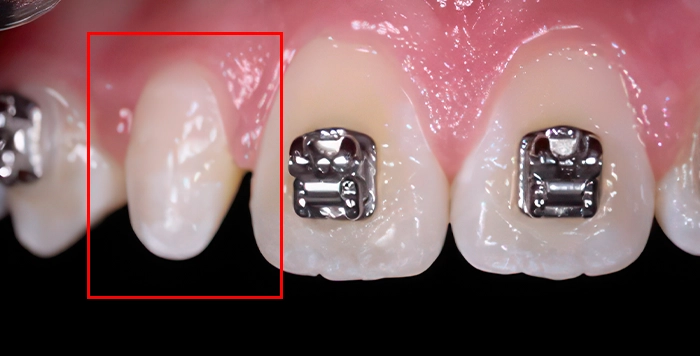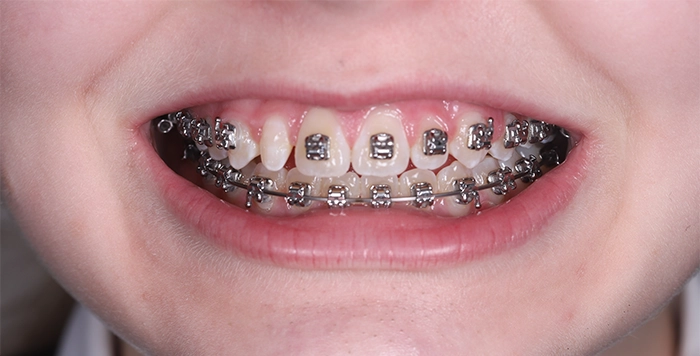Case Study
Conservative Resin Veneer for a Peg Lateral Incisor
A subtle smile transformation

Restoring balance and harmony to a teen’s smile
A common dental characteristic, frequently observed as a familial trait, is a peg lateral incisor. This refers to a lateral front tooth that is noticeably smaller and more tapered than its neighbours. While this condition does not impair oral function, it can subtly affect the symmetry and overall balance of a smile.
This case study from Simply Teeth outlines Dr. Su Lin’s conservative approach to treating a peg lateral incisor in a teenage patient, emphasising the preservation of natural tooth structure and the achievement of improved tooth symmetry.

Understanding Peg Lateral Incisors
A peg lateral incisor is characterised by one of the small teeth adjacent to the two central front teeth being naturally smaller or more pointed than average. This naturally occurring variation is benign but can disrupt the symmetry of an otherwise balanced smile.

Patient Presentation and Treatment Planning
Miss B, a teenage patient, presented at our practice with a prominent concern: her upper right lateral incisor was significantly smaller than its adjacent tooth, creating an aesthetic imbalance in her smile. Her oral health was optimal, with no existing cavities or gum issues, rendering her an ideal candidate for a cosmetic intervention.
At Simply Teeth, our approach prioritises conservative, patient-centred care, carefully considering the patient’s age, overall oral health status, and their specific aesthetic goals. For Miss B, the objective was not a dramatic aesthetic transformation, but rather a gentle enhancement to achieve a natural, age-appropriate smile with improved balance. Dr. Su Lin and the Simply Teeth team collaborated closely with Miss B and her family to formulate a minimally invasive solution focused on restoring both tooth proportion and function. The comprehensive treatment plan involved two key stages: orthodontic alignment followed by the precise placement of a resin veneer.

Step 1: Orthodontic Alignment
Prior to any direct cosmetic treatment, it was essential to ensure optimal dental positioning. Through close collaboration with Miss B’s orthodontist, braces were utilised to guide her teeth into a more ideal alignment. This crucial initial step served to create the necessary space around the peg lateral incisor, thereby facilitating the harmonious integration of the subsequent veneer with her natural dentition.
Step 2: Resin Veneer Placement
Upon completion of the orthodontic phase, the definitive step involved the application of a resin veneer. A resin veneer represents a minimally invasive method for reshaping a tooth. Dr. Su Lin meticulously sculpted and polished a tooth-coloured resin material directly onto Miss B’s smaller lateral incisor. This technique is notable because it requires no drilling or significant alteration to the natural tooth structure, which is a significant advantage.
Resin veneers are particularly well-suited for young patients due to their ability to preserve natural tooth structure and the inherent flexibility to be adjusted or replaced later as facial development continues. Meticulous attention was paid to matching the shape, shade, and texture of the resin to Miss B’s surrounding natural teeth, ensuring a seamless and aesthetically integrated result.
Before

After


Outcome: Even, Symmetrical Smile
The intended outcome was a subtle enhancement, rather than a radical change. Miss B’s newly placed resin veneer blended seamlessly with her existing teeth, contributing to a smile that appeared even, symmetrical, and entirely natural. The tooth that previously stood out now harmonised with the rest of her dentition.
A conservative approach to cosmetic dentistry
At Simply Teeth, we advocate for and provide conservative cosmetic dental solutions. For individuals with dental concerns such as a peg lateral incisor, these treatments can yield meaningful visual and emotional benefits. Resin veneers, whether applied as a standalone treatment or in conjunction with orthodontics, offer a viable option to modify tooth shape or size while maximising the preservation of natural tooth structure.
We are dedicated to helping our patients explore the most suitable options for their unique smiles at every stage of life.

* This case study is presented for educational purposes only. Individual treatment outcomes may vary significantly for each patient, and the results described in this case study should not be interpreted as a guarantee of specific outcomes for other individuals. A comprehensive consultation with a qualified dental professional is required to assess your specific needs and determine the most appropriate and suitable treatment plan for your individual oral health condition.
